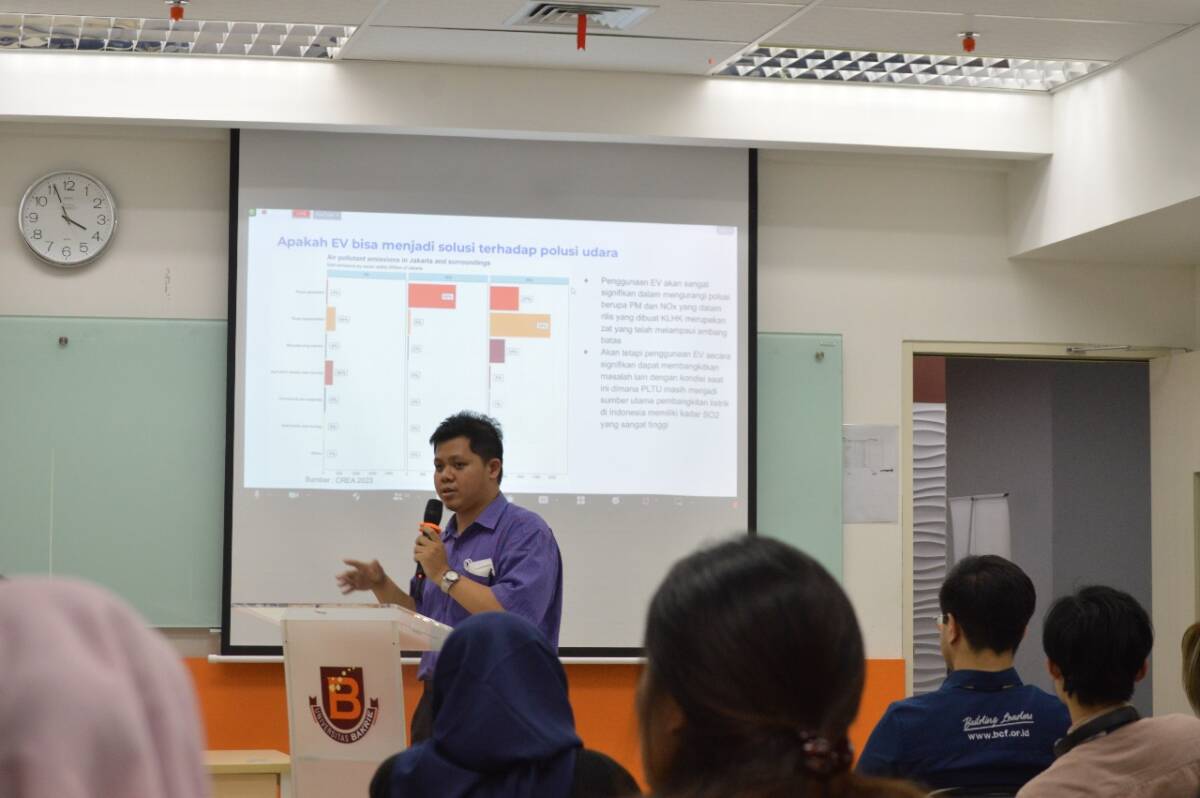Jakarta, June 7, 2024 – The Government should take more robust measures to promote the reduction of carbon emissions in the land transportation sector. Transportation is one of Indonesia’s significant greenhouse gas (GHG) emissions sources. This was revealed by Faris Adnan Padhilah, Research Coordinator of the Energy Demand Management Section, Institute for Essential Services Reform (IESR), in the Edutalk on Green Mobility and Transportation event organized by Bakrie University on Thursday (6/6/2024).
Citing an IESR study titled Indonesia Energy Transition Outlook (IETO) 2024, the transportation sector has produced emissions of 150 million tons of CO2e in 2022, making it the third largest contributor after the energy and industrial sectors. Of this amount, around 135 million tons of CO2e, or 90 percent, came from land transportation, of which passenger vehicles contributed around 106 million tons of CO2e, or 78 percent.
“The increase in passenger vehicles each year is also directly proportional to the increasing need for fuel oil (BBM), most of which is still imported. At least 52 percent of Indonesia’s total fuel consumption is imported from 2015 to 2020. During the same period, the Government spent an average fuel subsidy of IDR 64 trillion annually, or around IDR 175 billion daily. This high dependence on imported fuel affects the state budget and threatens national energy security,” said Faris.
“Given these circumstances, promoting efforts to reduce greenhouse gas emissions in the transportation sector is important. This is in line with the commitment to reach net zero emissions by 2050 as per the Paris Agreement, or to achieve net zero emissions (NZE) by 2060 as targeted by the Indonesian Government,” said Faris.
Faris mentioned the Ministry of Energy and Mineral Resources (ESDM) aims to achieve a net zero scenario by reducing 48 percent of the transportation sector’s greenhouse gas (GHG) emissions by 2050. Several measures have been designed to accomplish this, including using hydrogen and bioenergy to fulfill one-third of transportation energy needs, promoting the electrification of land transportation, improving gasoline efficiency, and encouraging mode switching.
One of the efforts to encourage the electrification of land transportation, said Faris, is using electric vehicles. Citing the IETO 2024 study, the total cost of ownership of electric cars is about 7 percent cheaper for two-wheeled vehicles and 14 percent for four-wheeled vehicles, even though electric cars have a more expensive selling price. These savings come from more affordable operating costs and fewer components requiring maintenance. Battery prices that are predicted to continue to become cheaper will make the selling price of electric vehicles more affordable.
“The use of electric vehicles has a significant impact in reducing pollution, but the current condition is not ideal because the electricity used to fuel electric vehicles still comes from highly polluting power plants. Therefore, the transition to using cleaner energy needs to be carried out by vehicles with electric vehicles and, at the same time, also replacing CFPPs with renewable energy. The use of electric vehicles without being accompanied by a transition in energy supply will reduce carbon dioxide (CO2) but not reduce NOx and even increase sulfur dioxide (SO2) and particulate matter (PM),” added Faris.
Faris emphasized that decarbonizing the electricity grid is necessary to reduce vehicle emissions further. As of 2023, emissions from the electricity grid are approximately 0.873 grams of CO2 per kilowatt-hour (kWh) and are projected to decrease to 0.754 grams of CO2 per kWh by 2030. Additionally, electric vehicle emissions per kilometer are 18% lower for two-wheelers and 25% lower for four-wheelers than conventional vehicles; these figures are expected to improve to 24% for two-wheelers and 33% for four-wheelers. Suppose the electricity used to charge the electric motor generates no carbon emissions. In that case, vehicle emissions per kilometer are expected to be 48% lower for two and 80% lower for four.
“Currently, the adoption of electric vehicles is hampered by performance, infrastructure, and after-sales prices. The Government has also provided assistance schemes and fiscal incentives to increase the adoption of electric vehicles. However, the average electric vehicle available in 2023 is still more expensive than the average selling price of conventional cars. As for electric motors, there are performance limitations, especially regarding mileage, which is one of the barriers to their adoption,” added Faris.
Faris assessed that the electric motors on the market are dominated by motors with lower performance in terms of mileage, top speed, and max power, with prices that are not much different from electric motors in India. Meanwhile, electric motorcycles in India have a longer mileage.
“In addition, the low utilization rate of public electric vehicle charging stations (SPKLU) slows down the break-even point of business investment. IESR analysis found that, by 2023, the ratio of SPKLUs to electric cars is 1:25. However, based on data from Jakarta and West Java, the average use of SPKLU is only 1.24 and 0.26 transactions per day. Faris assessed that this low usage rate makes it very difficult for the SPKLU business to reach the break-even point (BEP),” said Faris.
According to Faris, there are strategies to further avoid, shift, and improve to encourage decarbonization in the land transportation sector. The avoid strategy relates to reducing the demand for human movement or distance traveled. One well-known policy in this strategy is the work-from-home policy, or the compact city policy, where individuals only need to walk around 15 minutes to fulfill their daily needs.
“Furthermore, the shift strategy means using mass vehicles that can reduce emissions cumulatively. Finally, the improved strategy means increasing the energy efficiency of the vehicles used,” said Faris.

